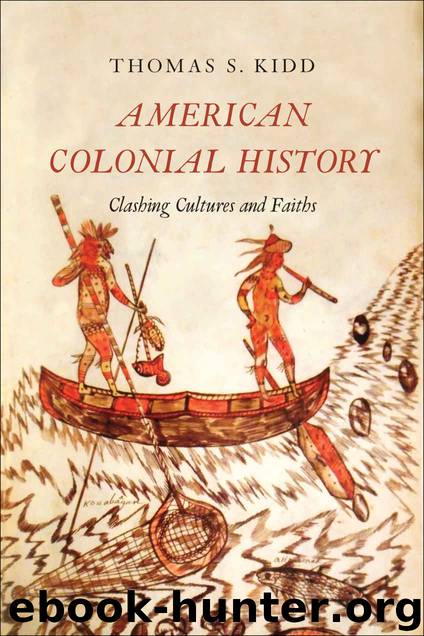American Colonial History: Clashing Cultures and Faiths by Kidd Thomas S

Author:Kidd, Thomas S.
Language: eng
Format: epub
Publisher: Yale University Press
Published: 2016-04-25T16:00:00+00:00
Virginia’s turn to slavery transpired over a longer period of time, as its supply of African slaves in the early and mid-1600s was limited by imperial and economic factors in the broader Atlantic world. Virginia planters struggled to establish the colony as an important player in the transatlantic slave trade. But those Virginia elites who had the resources and connections turned to slave labor in the tobacco fields as soon as they could. On the eve of Bacon’s Rebellion in the 1670s, large-scale planters who owned mostly black instead of white laborers had begun to emerge in the Tidewater region of Virginia. Bacon’s Rebellion—fueled by resentments of white servants who had lived through their terms of indenture—may have implicitly cautioned some planters of the risks of overdependence on white indentured servants. But many of those planters had already begun building their workforce upon African slaves, anyway. By the 1710s, a number of the large planters had hundreds of slaves working for them, with relatively few white servants, and even modest landowners were getting access to affordable enslaved people.11
As seen in the Caribbean and lower South, the growth of African slavery in Virginia came with increased codification of racial categories that set “black” or “negro” apart from “white” or “Christian.” This created anxiety about the sexual mixing of races, which precipitated a 1662 Virginia law stipulating that “children got by any Englishman upon a negro woman” would follow the status of the woman, meaning that mixed-ethnicity children born to a black slave woman would be slaves, too. It also threatened punishments against any “Christian [who] shall commit fornication with a negro,” implying that Africans were by definition non-Christian (ignoring the slaves who had Christian influences in their African background, or who affiliated with Anglican churches in the colony). Yet in 1667 the legislature passed another statute regarding slave children, clarifying that when masters allowed the children of slaves to be baptized, that did not make the children free. The legislature hoped to relieve masters from fear of Christianizing their slaves, although the statute does not seem to have had that effect. Many remained reluctant about evangelistic overtures toward blacks and Native Americans. One woman told Anglican minister Morgan Godwyn that baptism was “to one of those [slaves] no more beneficial, than to her black bitch.” When Godwyn left Virginia to minister in Barbados, he found similar resistance, as some planters believed that “baptizing of their negroes is the ready way to have all their throats cut,” or to foment slave rebellion.12
The laws of early Virginia mixed religious and racial categories to define the nature of slavery. A 1682 statute specified that slaves, whether Africans, Indians, or “Moors,” were people brought into the colony who did not have a Christian background. A 1705 law specified the rights of “white Christian” servants, admonishing masters to show “Christian care and usage of all Christian servants.” It remained silent about the rights of (African, or perhaps Indian) slaves, and prohibited “negros, mulattos, or Indians” from owning Christians as servants.
Download
This site does not store any files on its server. We only index and link to content provided by other sites. Please contact the content providers to delete copyright contents if any and email us, we'll remove relevant links or contents immediately.
| African Americans | Civil War |
| Colonial Period | Immigrants |
| Revolution & Founding | State & Local |
Cat's cradle by Kurt Vonnegut(13868)
Pimp by Iceberg Slim(12932)
Underground: A Human History of the Worlds Beneath Our Feet by Will Hunt(11258)
4 3 2 1: A Novel by Paul Auster(11052)
The Radium Girls by Kate Moore(10907)
American History Stories, Volume III (Yesterday's Classics) by Pratt Mara L(4827)
Perfect Rhythm by Jae(4621)
Wiseguy by Nicholas Pileggi(4586)
The Fire Next Time by James Baldwin(4343)
Paper Towns by Green John(4169)
A Higher Loyalty: Truth, Lies, and Leadership by James Comey(4033)
Pale Blue Dot by Carl Sagan(4001)
The Mayflower and the Pilgrims' New World by Nathaniel Philbrick(3915)
The Doomsday Machine by Daniel Ellsberg(3731)
Too Much and Not the Mood by Durga Chew-Bose(3696)
Killers of the Flower Moon: The Osage Murders and the Birth of the FBI by David Grann(3609)
The Borden Murders by Sarah Miller(3590)
The Sympathizer by Viet Thanh Nguyen(3482)
Killing England by Bill O'Reilly(3455)
